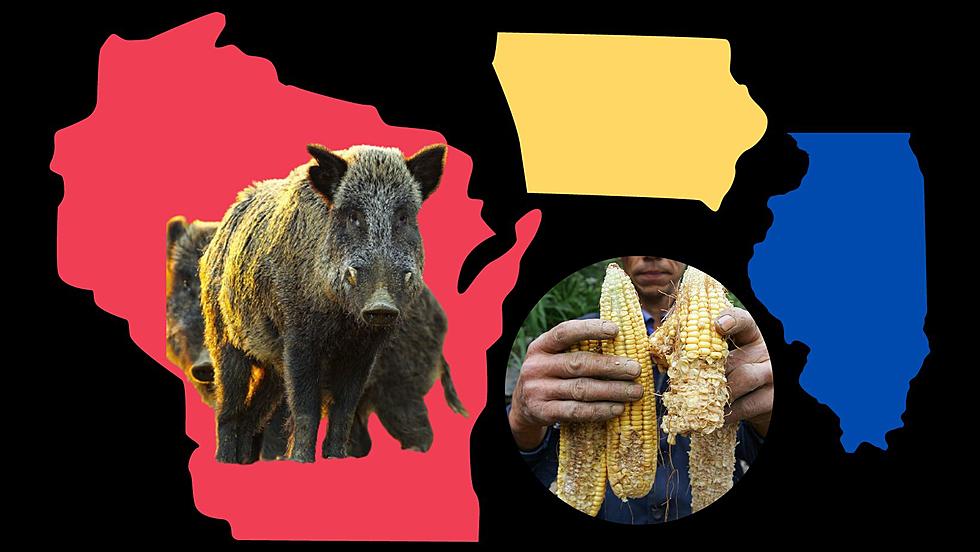
Destructive ‘Super Hogs’ Found In Wisconsin! Are Illinois and Iowa Next?
Back in June, I posted about the next destructive critter making its way down from Canada. The properly named 'Super Hogs,' may have been a great thought for Canadian farmers, but now those released hogs are wreaking havoc across the northern US with sights set on the Midwest as a whole. The super pigs have already crossed into North Dakota from Canada, and their spread is increasing, reaching states including Montana, Minnesota, and Michigan.
Wisconsin, renowned for its picturesque landscapes and diverse wildlife, is now facing this daunting challenge. The Wisconsin Department of Natural Resources (DNR) is actively investigating sightings of these super pigs, particularly in Florence County. Feral hogs are a hybrid mix of escaped domestic pigs and Eurasian wild boars.
Why Don't We Want 'Super Pigs' in the USA?
While the situation appears isolated for now, the DNR is taking a proactive stance, closely monitoring the reported cases and urging residents to report any sightings. They provide both printable and online reporting forms on their website, encouraging community involvement in tracking and managing the feral pig population. Did you know that females can give birth to 4 to 12 piglets up to twice a year!?
How can we help manage a hog population?
Feral pigs are considered exotic and non-native in Wisconsin. They pose a significant threat to both the environment and agricultural operations. That's why the Wisconsin DNR advocates for aggressive removal measures wherever feral pigs are reported, recognizing the potential consequences of their presence.
Typical crop damage from wild hogs.
Regulations implemented by the DNR allow the removal of feral hogs throughout the year with a valid small game license and landowner permission. Landowners have the authority to shoot feral pigs on their property without a hunting license under the DNR's animal nuisance control authority. Additionally, people found operating captive feral pig hunting facilities, stocking feral pigs for hunting, releasing hogs into the wild, and possessing live feral hogs without a permit will be dealt with harshly.
What's the difference between a pig and a 'super pig?'
The physical characteristics of feral pigs include a mid-sized, stocky build with coarse, long bristles on their backs and display considerable variation in color and size. Other distinctive features of feral pigs include elongated snouts, erect pointed ears, and continually growing tusks in boars, making them easy to identify.
Adaptability is a key trait of these invasive feral pigs. It allows them to inhabit a wide range of habitats, with a territory covering about 10 square miles and even expanding up to 50 square miles if food is scarce. And boy can they eat! Feral hogs feed on plants and animals, with a particular fondness for acorns, hickory nuts, and agricultural crops.

'Super Pigs' already sound bad. How much worse can they get?
Their feeding habits also come with an additional cost to the environment, agriculture, and public health. Feral pigs cause significant financial losses by damaging crops, pastures, facilities, and fences. Not only will they decimate your local food sources and destroy your land, but they could also leave you with a nasty disease. Diseases like pseudorabies, brucellosis, and tuberculosis are of particular concern, especially for farmers worried about the spread of exotic diseases in their livestock.
Unfortunately, the damage doesn't end there. Trampling and rooting behaviors have caused population declines in grassland birds, wetland wildlife, and various small mammals. The DNR is committed to addressing this ecological impact by actively documenting the consequences of feral pig presence on native flora and fauna.
Overall, here's the big deal with these super pigs?
- Contaminate water sources with E. coli and other bacteria, putting public safety and health at risk
- Damage natural habitats, displacing wildlife and negatively impacting biodiversity
- Uproot and trample crops, destroying farmers’ hard work
- Can carry up to 89 diseases, threatening farm livestock
- Reproduce alarmingly fast, with females giving birth to 4 to 12 piglets up to twice a year
The emergence of feral pigs in Wisconsin is cause for major concern. The Wisconsin DNR's proactive approach, including monitoring, reporting, and regulatory measures, reflects the urgency of addressing this issue to safeguard the state's environment, agriculture, and wildlife. Community awareness and involvement are crucial in the collective effort to manage and control the feral pig population, preserving Wisconsin's natural beauty and biodiversity.
WATCH OUT: These are the deadliest animals in the world
States with the most registered hunters
Gallery Credit: Meagan Drillinger
Photos: Governor Dodge State Park, Wisconsin
Gallery Credit: Tom Ehlers

